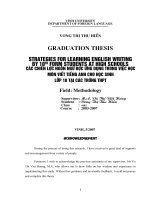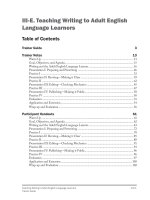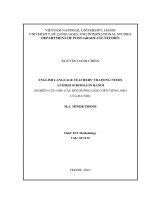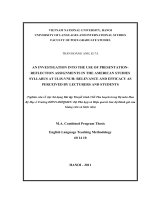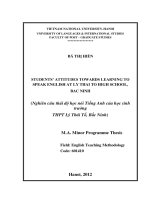Students’ unwillingness to speak english in english language classroom as perceived by students and teachers at high schools in hanoi
Bạn đang xem bản rút gọn của tài liệu. Xem và tải ngay bản đầy đủ của tài liệu tại đây (1.27 MB, 69 trang )
VIETNAM NATIONAL UNIVERSITY, HANOI
UNIVERSITY OF LANGUAGES AND INTERNATIONAL STUDIES
FACULTY OF ENGLISH LANGUAGE TEACHER EDUCATION
GRADUATION PAPER
STUDENTS’ UNWILLINGNESS TO SPEAK ENGLISH
IN ENGLISH LANGUAGE CLASSROOM AS
PERCEIVED BY STUDENTS AND TEACHERS AT
HIGH SCHOOLS IN HANOI
Supervisor: Dr. Vũ Hải Hà
Student: Phùng Thị Mai Phương
Course: QH2012.F1.E7
HÀ NỘI – 2016
ĐẠI HỌC QUỐC GIA HÀ NỘI
ĐẠI HỌC NGOẠI NGỮ
KHOA SƯ PHẠM TIẾNG ANH
KHĨA LUẬN TỐT NGHIỆP
SỰ KHƠNG SẴN LÕNG NĨI TIẾNG ANH CỦA HỌC
SINH TRONG LỚP HỌC TIẾNG ANH NHẬN BIẾT BỞI
GIÁO VIÊN VÀ HỌC SINH CẤP 3 Ở HÀ NỘI
Giáo viên hướng dẫn: Tiến sĩ Vũ Hải Hà
Sinh viên: Phùng Thị Mai Phương
Khóa: QH2012.F1.E7
HÀ NỘI – 2016
Signatures of Approval:
______________________________________________________________________
Supervisor‟s comments , including suggestion for improving the speed and quality of
the thesis:
i
ACCEPTANCE PAGE
I hereby state that I: Phung Thi Mai Phuong (QH2012.F.1.E7), being a
candidate for the degree of Bachelor of Arts (TEFL) accept the requirements of the
University relating to the retention and use of Bachelor’s Graduation Paper deposited
in the library.
In terms of these conditions, I agree that the origin of my paper deposited in the
library should be accessible for the purposes of study and research, in accordance with
the normal conditions established by the librarian for the care, loan or reproduction of
the paper.
Signature
Date
May 1, 2016
ii
ACKNOWLEDGEMENTS
I would like to express my deep sense of gratitude to many people who
considerably helped me to accomplish this thesis.
First and foremost, I owe my deepest gratitude to Dr. Vu Hai Ha, who helpfully
guided me throughout the thesis. I am blessed to have had his supervision, his helpful
guidance, his affection, support and encouragement. Had it not been for his help, this
thesis could not have been completed.
I also wish to thank Mrs. Nguyen Thi Thanh Loan, Mrs Nguyen Thu Hang and
181 students from Cao Ba Quat and Yen Vien high school for their participation in the
research. I genuinely appreciated Mrs Nguyen Thi Thanh Loan‟s advice and
contributions to my study. Her passionate enthusiasm for teaching inspired me a lot.
I wish to extend my warmest thanks to my close friends who have been always
supported and encouraged me in my tough time. I would like to send my thanks to Ms Le
Thi Hoai Thu for her strong encouragement for me to continue the thesis.
Last but not least, I am greatly indebted to my family especially my mother, who
always give me unconditional love and care. I offer my regards and blessings to all of
them.
iii
ABSTRACT
Students‟ unwillingness to speak in English language classroom after nearly 10 years
studying English at schools has become an urgent problem because of the demand for
communication in English. This study investigates to what extent students at high schools
in Hanoi remain unwilling to speak English. In addition, it finds out the reasons for
students‟ unwillingness to speak English as perceived by both students and teacher at 2
high schools in Hanoi.
181 students and 2 teachers from Cao Ba Quat high school and Yen Vien high school
were invited to participate in the research. Both quantitative and qualitative data analysis
methods were applied to the study. The perceptions of both student and teacher
participants were investigated through multiple methods: questionnaires, interviews and
stimulated recalls. After the questionnaires, data was analysed to chose participants for
interviews and stimulate recalls.
Findings from questionnaires showed that the extent to which students remain unwilling
to speak English in English language classroom was not too high. However, the validity
of the results from questionnaires was not proved. Data from interview and stimulated
recall helped to find out the reasons for students‟ unwillingness to speak English. As
perceived by students, 10 reasons synthesized were: Low group cohesiveness, Lack of
teacher support, Low risk-taking, Less tolerance of ambiguity, Lack of motivation, Fear
of negative evaluation, Language anxiety, Unfamiliar Topic, Lack of interest, and Bad
experiences. From teacher‟s perceptions, individual characteristics, lack of teacher
support, low risk-taking and language anxiety were affective factors.
iv
TABLE OF CONTENTS
ACCEPTANCE PAGE ....................................................................................................... ii
ACKNOWLEDGEMENTS ............................................................................................... iii
ABSTRACT ........................................................................................................................iv
LIST OF TABLES, FIGURES AND ABBREVIATIONS .............................................. vii
CHAPTER 1: INTRODUCTION ........................................................................................ 1
1.
Problem Statement and Rationale .................................................................................. 1
2. Research Questions............................................................................................................ 2
3. Significant of the study ...................................................................................................... 2
4. Scope of the study.............................................................................................................. 3
5. Thesis structure .................................................................................................................. 3
CHAPTER 2: LITERATURE REVIEW ............................................................................. 5
1.1 Definition of key terms .................................................................................................. 5
1.1.1
Unwillingness .................................................................................................. 5
1.1.2
Speaking English ............................................................................................. 5
1.1.3
Unwillingness to speak .................................................................................... 6
1.1.4
Unwillingness to speak in English language classrooms ................................ 6
1.2 Overview of reasons for students‟ unwillingness to speak ............................................ 7
1.3 Dynamics of classroom communication in ELC ......................................................... 13
1.4 Related studies ............................................................................................................. 14
1.5 Research gap ................................................................................................................ 16
CHAPTER 3: METHODOLOGY ..................................................................................... 17
2.1 Research approach ....................................................................................................... 17
2.1.1
Context of the study ....................................................................................... 17
2.2 Participant selection ..................................................................................................... 18
2.2.1 Participants for questionnaires ........................................................................... 19
v
2.2.2 Participants for interviews and stimulated recall ............................................... 20
2.3 Instruments ................................................................................................................... 22
2.3.1 Face-to-face questionnaire .............................................................................22
2.3.2
Semi-structured interview ..........................................................................24
2.3.3
Stimulated Recall .......................................................................................24
2.4 Data collection ............................................................................................................... 25
2.4 Data analysis ................................................................................................................ 27
CHAPTER 3: FINDINGS AND DISCUSSION ............................................................... 28
3.1 Result of research question 1 ......................................................................................... 28
3.2 Result of research question 2 ......................................................................................... 33
3.3 Result of research question 3 ......................................................................................... 40
CHAPTER 4: CONCLUSION .......................................................................................... 43
4.1 Summary of key findings .............................................................................................. 43
4.2 Contribution of the study ............................................................................................... 43
4.3 Limitations of the study ................................................................................................. 44
4.4 Suggestion for further study .......................................................................................... 45
LIST OF REFERENCES ................................................................................................... 46
APPENDIX A: Questionnaires .......................................................................................... 50
APPENDIX B: Sample of Students‟ interviews ................................................................ 53
APPENDIX C: Sample of Teachers‟ interviews ............................................................... 57
vi
LIST OF TABLES, FIGURES AND ABBREVIATIONS
LIST OF TABLES
Table 2.1 Distribution of number of participants ……………………………………….19
Table 2.2 Description of student participants……………………………………….......20
Table 2.3 Distribution of number of participants in interviews and stimulated recall......21
Table 2.4 Schedule of data collection procedures
………………………………...21
Table 2.5 Data analysis for each question ……………………………………………….22
Table 2.6. Construction of questionnaires…………………………..………………….23
Table 2.7 Schedule of data collection procedures…………………….…………………26
Table 2.8 Data analysis for each question…………………………….………………....27
Table 3.1: Descriptive statistics of the overall WTS
………………………………...29
Table 3.2: Descriptive statistics of each degree of willingness…………………….........30
Table 3.3 Descriptive statistics of each class…………………………………………….32
Table 3.4 Descriptive statistics of reasons for students‟ UTS…………………………...33
Table 3.5 Reasons for students‟ UTS from interview……………………………………35
Table 3.6 Reasons for students‟ unwillingness to speak English perceived by teachers...40
vii
LIST OF FIGURE
Figure 1.1: Heuristic Model of WTC in L2 of MacIntyre et al. (1998)………………….8
Figure 1.2: Wen and Clément‟s (2003) model of WTC for EFL students in China……10
Figure 1.3: A Framework for Understanding Communication in Second Language
Classrooms……………………………………………………………………………….14
Figure 3.1 Extent of agreement of lowest mean score and highest mean score items….33
viii
LIST OF ABBREVIATIONS
CLT
Communicative Language Teaching
ELC
English Language Classroom
GTM
Grammar Translation Method
MOET
Ministry of Education and Training
L1
First Language
L2
Second Language
UTS
Unwillingness to speak
WTC
Willingness to Communicate
ix
CHAPTER 1: INTRODUCTION
This introductory chapter presents an overview of the study. It starts with the problem
statement and rationale for the study, followed by the clarification of the research aims
and research question. Then, it provides the significance and the scope of the study.
Finally, the thesis structure is introduced to help readers have a brief overview of the
research carried out.
1. Problem Statement and Rationale
In the light of globalization, English plays an important role in communication among
people all over the world. Communicative Language Teaching (CLT), the language
teaching methodology that emphasizes the essential role of communication (Brumfit,
1979), therefore, has been widely used instead of Grammar Translation Method (GTM).
According to Richards (2006), while grammatical competence is an important dimension
of language learning, one can master the rules of sentence formation in a language and
still not be very successful at being able to use the language for meaningful
communication. MacIntyre et al. (1998) demonstrates the process underlying the
disposition to choose to speak a second language given the opportunity in a framework of
Willingness to Communicate (WTC). That framework was adapted by Wen and Clément
(2003) with more cultural factors especially applied to nonwestern classroom settings.
In Vietnam context, due to international integration trend, the demand for
communication in English has become urgent than ever. Therefore, instead of utilizing
traditional teaching method such as grammar translation teaching method or audiolingual method, Ministry of Education and Training (MOET) has had predisposition
towards CLT recently. However, there is no doubt that many English language learners in
Vietnam still encounter the problem of speaking English, which may lead to low chances
of getting a good job in the future, misunderstanding while communicating with
foreigners, etc. This problem happens not only to students who are not good at English in
general but also to those who demonstrate successfully in reading, listening and writing
1
skills. Liu and Littlewood (1997) discovered that the more speaking activities in which
students are engaged, the higher they rate their ability to speak and vice versa, which
indicates that students feel confident about their oral proficiency simply because they
have had a lot of practice in speaking. Nevertheless, it will be a huge challenge for
teachers to make students practice speaking in classrooms if they are not willing to do.
Unwillingness to speak in English language classrooms, therefore, has become one of the
most important issues in teaching language as a foreign language in Vietnam.
It was this problem that urged the researcher to conduct a research on students‟
unwillingness to speak in English language classroom. The study was carried out at two
high schools in Hanoi, which are Yen Vien high school and Cao Ba Quat high school.
The reasons for these choices and detailed descriptions of these two schools would be
presented in the third chapter, Methodology.
2. Research Questions
The research was conducted with the hope of discovering satisfactory answers to the
three following questions:
RQ1. To what extent do students at high schools in Hanoi remain unwilling to
speak in English language classrooms?
RQ2. What are the reasons for students’ unwillingness to speak English in
English language classrooms as perceived by students at high schools in Hanoi?
RQ3. What are the reasons for students’ unwillingness to speak English in
English language classrooms as perceived by teachers at high schools in Hanoi?
3. Significant of the study
This study needs to be conducted for several reasons. Firstly, based on the results of
the research, students and teachers can have a general look on to what extent students at
high schools remain unwilling to speak in English language classroom. In addition,
teachers can benefit directly from the study in discovering the reasons for students'
2
unwillingness to speak English, from which teachers make suitable changes in their own
behaviors as well as in classroom management, task, etc to enhance students' willingness
to speak. Similarly, this study can help to raise students' awareness of causes for students'
unwillingness to speak from the perceptions of teachers. Finally, this research can be
considered as a reliable source for further studies.
4. Scope of the study
Enormous as the number of English language learners in Vietnam is, this study
only concentrates on students and teachers at high schools in Hanoi. This is because
students at high school have been learning English for at least 7 years, which is long
enough for them to be able to speak English to some extent. Besides, since the researcher
used to study at Yen Vien high school and would have teaching practicum at Cao Ba
Quat High School, students and teachers at these two schools would be chosen as
participants of the study. To sum up, the researcher invited 181 students and 2 teachers
from those two schools to participate in the study.
5. Thesis structure
This research consists of five chapters:
Chapter 1: Introduction
This chapter presents an overview of the study, including the problem statement
and rationale for the study, followed by the clarification of the research aims and research
question. Then, the significance of study, the scope of the study and the thesis structure
are introduced.
Chapter 2: Literature review
This chapter introduces theories related to doing research such as definition of key
terms, overview of reasons for students' unwillingness to speak English in class,
dynamics of classroom communication in ELC, related studies and research gap.
3
Chapter 3: Methodology
This provides information about research approach, participants, instruments,
research design, data collection method and data analysis method.
Chapter 4: Findings and discussion
In this chapter, data collected will be analysed to answer three research questions
proposed. The results are presented and discussed in detail.
Chapter 5: Conclusion
This last chapter comprises summary of findings, contributions of the study,
limitations of the study and suggestions for further study.
4
CHAPTER 2: LITERATURE REVIEW
This chapter begins with definition of key terms related to the study, followed by an
overview of reasons for students‟ unwillingness to speak. Next, dynamics of classroom
communication in ELC will be demonstrated. The next section of this chapter is related
studies and the last one will be research gap.
1.1 Definition of key terms
1.1.1 Unwillingness
In Wen and Clément‟s (2003) conceptualisation of willingness to communicate, a
distinction was made between desire and willingness. According to them, desire refers to
a deliberate choice or preference, while willingness emphasises the readiness to act (Wen
and Clément, 2003). The definition of unwillingness in this study was interpreted from
their definition of willingness, which is unreadiness to act something. For example, a
person may desire or want to do a task, however, because of some difficulties he or she
may encounter, he or she is not ready to do it. That describes unwillingness term.
1.1.2 Speaking English
Definition of “Speak” as a verb in Oxford learner‟s dictionary is “to talk to
somebody about something; to have a conversation with somebody”. According to
Widdowson (1994), speaking is the active production skill and use of oral production. It
is the capability of someone to communicate orally with others. To evaluate speaking
skill of English, 4 main criteria are based on. They are Fluency and Coherence, Lexical
Resource, Grammatical Range and Accuracy, and Pronunciation (Xia, 2010, p.13).
5
1.1.3 Unwillingness to speak
One of the earliest studies on unwillingness to communicate in L1 is that of
Burgoon (1976). According to her, unwillingness-to-communicate was defined as „„a
chronic tendency to avoid and/or devalue oral communication and to view the
communication situation as relatively unrewarding‟‟ (p. 60). Burgoon (1976) stated that
“the major lines of research supporting the unwillingness to communicate construct are
those on anomia, alienation, introversion, self-esteem and communication apprehension”.
Following the earlier work of Burgoon (1976) and others, McCroskey and Baer
(1985) conceptualized willingness to communicate (WTC) “as the probability of
engaging in communication when free to do so” (MacIntyre, Clément, Dornyei & Noels,
K.1998, p.546).
1.1.4 Unwillingness to speak in English language classrooms
Based on „Unwillingness to Communicate‟ (Burgoon, 1976), „Predisposition to
Verbal Behavior‟ (Mortensen, Arnston & Lusting, 1977) and „Shyness‟ (McCroskey &
Richmond, 1982), the concept of Willingness to communicate (WTC) in L2 emerged in
the mid 1980s. For the first time, MacIntyre and Charos (1996) applied the WTC model
to second language settings and showed that personality and social context had an effect
on the frequency of second language (L2) use as well as WTC.
Later, MacIntyre et al. (1998) broadened what was proposed by MacIntyre and
Charos (1996) on the assumption that WTC in L2 could not simply obvious WTC in firstlanguage (L1) users (p.546). The rationale behind the lack of transferability of WTC from
L1 to L2 was justified by greater difference in L2 users‟ communicative competence and
social factors influencing L2 use (MacIntyre et al., 1998; Cao & Philip, 2006). Looking at
WTC as a situational construct, they defined L2 WTC as „„readiness to enter into
discourse at a particular time with a specific person or persons, using a L2” (p. 547).
6
In this study, the researcher based on the definition of WTC of MacIntyre et al. (1998)
to infer unwillingness to speak in English language classrooms, which is “unreadiness to
enter into oral discourse in English language classrooms at a particular time with a
specific person, using English.”
1.2 Overview of reasons for students’ unwillingness to speak
There are many reasons assumed to cause unwillingness to communicate. Burgoon‟s
research associated the unwillingness-to-communicate construct with (1) anomia and
alienation, (2) introversion, (3) low self-esteem and (4) high communication
apprehension. Firstly, anomics are those who fail to adopt society‟s norms and values.
Consequently, they often feel insecure, powerless, alone, socially isolated and alienated
from society. The reason why they avoid communication is that they perceive
communication experiences to be negative and the reason why they distrust
communication is that they distrust other
people.
Secondly, introverts
are
characteristically quiet, timid and shy because their lower need for communication and
their anxiety. Thirdly, people with low self-esteem are more persuasible and conforming
due to their less faith in their own opinions. They expect others to reject or criticize their
communication efforts, which leads to their unwillingness to communication. The forth
reason mentioned by Burgoon is communication apprehension and reticence. According
to Burgoon (1976), communication apprehension or reticence people are insecure, feels
inadequate in communication, is easily embarrassed, shy, withdrawn and prone to agree
with others. However, because these reasons are for unwillingness to speak in L1, factors
related to language competence were not mentioned. It cannot be denied that a lot of
students refuse to speak English due to their low English proficiency. Therefore, other
studies should be investigated.
The Heuristic Model of L2 WTC developed by MacIntyre et al. (1998) describes six
categories or variables regarded as six layers of the model (figure 1). There are two basic
7
structures inside the model. The first three layers (I, II and III) represent situation-specific
influences on WTC at a given moment in time and the latter three layers (IV, V and VI)
represent stable and enduring influences on L2 WTC. Moving from the top to the bottom
of the model means moving from the most immediate situational to the more stable and
enduring influences on L2 communication situations. This is the most suitable model for
this study because it focuses on L2 communication, therefore, it was used to analyze
reasons for students‟ unwillingness to speak in English language classrooms.
Figure 1.1: Heuristic Model of WTC in L2 of MacIntyre et al. (1998)
Note. From “Willingness to Communicate in the Second Language: Understanding the
Decision to Speak as a Volitional Process.” by P. D., MacIntyre, 2007, The Modern
Language Journal, 91, p. 568.
In Layer I, Communication Behavior is treated in a broad sense which includes
activities such as speaking up in class, reading L2 newspapers, watching L2 television or
utilizing a L2 on a job. These behaviors origin from behavioral intension described as
8
Layer II. In Layer II, Willingness to communicate can be explained by a simple example.
Supposing a teacher poses a question to the students in classroom, some of them are
likely to feel confident to answer and desire to speak. Assumed that they have to raise
their hands before speaking then all the students who raise their hands express WTC in
L2 although only one of them can actually verbalize the answer. The reasons why those
students raise their hands are explained in the figure. Because they wish to say something
to their teachers and their classmates are they are self-confident with their answers. So
behavioral intension is basically like “when I am given an opportunity to speak up, I plan
to speak up”. Layer III explained that their self-confidence in a particular situation comes
from their self-confidence with language competence. If they are not good enough at that
language to understand teacher‟s question and come up with answer, they cannot feel
confident to speak up in that case. Additionally, interpersonal and intergroup make them
have desire to speak with their teacher and classmates, maybe to please teacher or to get
good marks. Specifically, the desire to communicate with a specific person is
hypothesized to be encouraged by affiliation and control motives. A research in social
psychology reveals that affiliation often occurs with people who are physically attractive
and who are similar to us in a variety of ways (Lippa, 1994). Regarding State
Communication Self-Confidence, Clément (1980, 1986) described self-confidence with
two key constructs which are perceived competence and a lack of anxiety. Those
constructs, however, seem to be enduring while MacIntyre et al. (1998) make a
distinction between the trait-like confidence and a momentary feeling of confidence.
Concerning Layer IV, motivational propensities are based on the affective and cognitive
contexts of intergroup interaction and lead to state self-confidence and a desire to interact
with a particular person. Layer V addresses variables that are more remote from the
specific language learning and communication context. They are intergroup attitudes,
social situation and communicative competence. The last layer, the social and individual
context involves intergroup climate and personality. Specifically, intergroup climate
9
refers to the climate that communicator evolve in whereas the personality refers to stable
characteristics relevant to communication.
However, in MacIntyre‟s model, the cultural factor was not focused on, which is
likely to be suitable for Western context rather than Asian context. Wen & Clément
(2003) developed their own model based on their research in the Chinese EFL context.
Figure 1.2: Wen and Clément‟s (2003) model of WTC for EFL students in China
Note. From “A Chinese conceptualisation of willingness to communicate in ESL,” by
W.P. Wen and R. Clément, 2003, Language, Culture and Curriculum, 16, p. 25.
This model clarifies the process from the desire to communicate (DC) in Layer III to
willingness to communicate (WTC) in Layer II in MacIntyre et al.‟s (1998) model. Wen
and Clément distinguished between the DC and the WTC: “Desire refers to a deliberate
choice or preference, while willingness emphasizes the readiness to act” (2003, p. 25). It
is interpreted that every student may have a DC, but they may not end up speaking in
class because their DC is restrained by cultural-oriented factors (Pattapong, 2010). Wen
& Clément‟s model includes four factors which are Societal Context, Personality Factors,
Motivational Orientation, and Affective Perceptions. Firstly, about Societal Context, it
10
consists of group cohesiveness and teacher support. Cohesiveness is “the degree to which
the group coheres or hangs together” (Shaw, 1981). Shaw (1981) discovered that high
cohesiveness is positively related to group productivity, satisfaction, social influence in
the group and interaction. Both Shaw‟s theory and Wen and Clément‟s conceptualisation
share the concern that high group cohesiveness results in engagement and a pleasant
feeling and thus willingness to communicate. Teacher support is made of teacher‟s
attitude, involvement, immediacy, and teaching styles. Among those, teacher‟s
involvement and immediacy are believed to be the most effective. Teacher involvement
is regarded as the personal relationship between a teacher and his or her students (Reeve,
1996). If teacher‟s involvement is high, his or her students will feel less watched and
evaluated, then more secure and enthusiastic (Skinner and Belmont, 1993). Teacher
immediacy including verbal and non-verbal has positive influences on student motivation
(Frymier‟s, 1993). It creates a close, warm and friendly environment, thus minimize
anxiety and increase student engagement. Secondly, Personality Factors includes risktaking and tolerant of ambiguity. Risk-taking involves the willingness to venture social
embarrassment or smirks in front of one‟s peers (Beebe, 1983; Jonassen & Gra-bowski,
1993). Students who are afraid of taking risk fear looking ridiculous and losing their
identities. This leads to their unwillingness to speak in class. Beside risk-taking, tolerance
of ambiguity is also an important factor. Chapelle and Roberts (1986) noted that:
An L2 situation is considered „novel‟ by learners because the grammatical, lexical,
phonological and cultural cues are unfamiliar and therefore insufficient for them to
construct a meaningful interpretation. On the other hand, these cues may be perceived
as being too numerous to interpret, resulting in a „complex‟ situation.
Similarly, different English learners chose different ways to treat ambiguous learning
situations. Some of them face those ambiguous situations, whereas others avoid them.
Research by Naiman et al., (1975) has shown that students who were less tolerant of
ambiguity performed worse on both receptive and productive language test. Thirdly,
Motivational Orientation consists of affiliation and task orientation. Schachter (1967)
11
argues that people simply seem to want to be in the physical presence of others. Being
“submerged” in a group make them satisfied. It is clear that the need for affiliation is a
universal tendency. However, in Wen and Clément‟s conceptualization, affiliation
contains “cultural implications”. Chinese culture is basically dominated by collectivism,
which means that they feel comfortable when they are close to other group members.
Task orientation is likely to affect Chinese student engagement. Sensitive to social
judgement, they would go out of their way to avoid disapproval, which entails looking
good or smart in the presence of others. If they fail to accomplish their task in meaningful
communication in the target language, they risk losing face. When students are focused
on the task, they are likely to feel “empowered” in their pursuits, to exhibit active
engagement (Ames, 1992). The last element to be mentioned in the model is Affective
perception. In MacIntyre‟s model, the affective-cognitive context is presented in the fifth
layer, meaning that they has less direct impact on students‟ language learning and
communication. Nevertheless, in Wen and Clément‟s view, affective perceptions more
directly determine students‟ WTC at a given time. Affective perceptions in this model
include the inhibited monitor and the positive expectation of evaluation. In classroom
settings, Chinese students tend to follow books, order and rules. This makes them
approach English language with a defensive mind so that they can avoid making errors
and social embarrassment. An inhibited monitor, therefore, can reduce self-consciousness
and then anxiety. Expectation of a positive evaluation is an essential tendency in
interpersonal communication settings. According to Lim (1994), “face is not what one
thinks of oneself, but what one thinks others should think of one‟s worth”. If one gets
positive remarks, one‟s self-esteem is increased and, consequently, one has face (Yu &
Gu, 1990). In a positive communication environment, students feel secure taking risks,
initiating speech and working harmoniously with their peers in a group (Richards, 2006).
To conclude, Wen and Clément‟s conceptualization is more specifically suitable for
English language learners in China and for those in Asia in general. Vietnam is a country
12
which shares a lot of common cultural features with China, therefore, in this case, the
researcher would apply Wen and Clément‟s framework to her study.
1.3 Dynamics of classroom communication in ELC
There are substantial differences between classroom interaction and real life
communication. In class, teacher plays a powerful role in controlling class
communication patterns, especially in Vietnam. According to Vietnam culture, students
have to obey and respect teacher in most of the situations. In an English language class, it
is the teacher who decides whether students have to speak with the teacher or they have
to speak with their partners. Therefore, to possess accurate understanding of classroom
communication patterns it is necessary to investigate not only students‟ perception but
also teacher‟ of the classroom interaction. There are two dimensions to be examined
which are the actions and interactions actually occurring in L2 classroom, and what
students and teacher bring to the L2 classroom (Barnes, 1976, cited in Johnson, 1995).
The frame work for understanding communication in L2 classroom is adapted from
Barnes‟ model (Johnson. 1995). The box on the left hand represents native language and
L2 language that they have acquired through their real life experiences. It characterizes
the frames of references through which the students use language to interact with the
world around them. However, how this knowledge is demonstrated in classroom relies on
patterns of classroom communication, which is shown in the center of the framework.
These patterns are changeable because it depends on how teacher control the patterns of
communication and how students interpret and respond to teacher‟s control. Lastly, the
way students speak English in ELC is a result of teachers‟ control and students‟
perception of the communication patterns.
13
Figure 1.3: A Framework for Understanding Communication in Second Language Classrooms
Note. From Understanding communication in second language classrooms.
(p. 8), by K. E. Johnson, 1995, Cambridge UP.
1.4 Related studies
1.4.1 Study abroad context
A research called “Why are some students reluctant to use L2 in EFL speaking classes?
An action research at tertiary level” by Merve Savaỗ (2014) was taken place in Turkey.
This study is more closely related to the researcher‟s study because they both have a
further look at speaking English in EFL classes. 22 young adults aged between 18 and 25
took part in the research. The participants‟ native language is Turkish and they are
advanced-level English students. The data were collected through both qualitative and
quantitative methods which are questionnaire and semi-structured interview. Data
14



